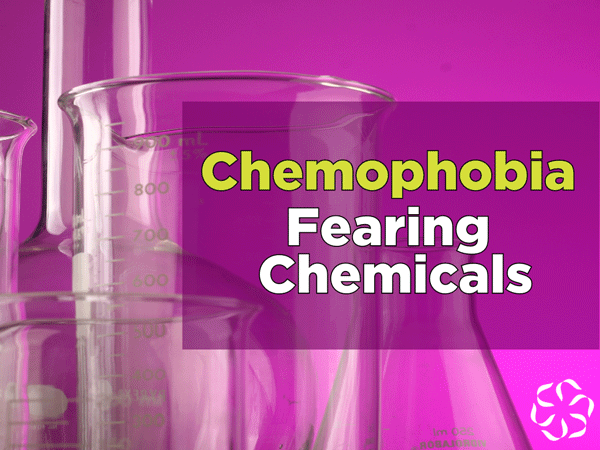When it comes to chemicals, it can be hard to untangle the facts from the fear (some of it’s necessary fear). In this post we explore chemophobia.
What is chemophobia?
Simply put, chemophobia is the fear or aversion to chemicals and chemistry.
In this post, we’ll focus on the emotions chemicals may invoke in us when related to food, cosmetics, and other household items.
What is a chemical?
Chemicals are the building blocks of life. Every living, breathing creature is made of chemicals. Every building we’ve entered is made of chemicals. Every product we’ve ever purchased and used is made of chemicals. Every food we’ve eaten is made up of chemicals.
When we think of chemicals it’s easy to think they’re artificial, human-made additions to our lives, rather than the foundation of our lives. Even things we may not think of as chemicals, like water, oxygen, sugar, protein, DNA are all examples of chemicals.
The foundation of our world and the chemicals that make up our world is found in the periodic table of elements. Everything around us, including us, is made of these elements or different combinations of these elements. Essentially the periodic table shows us the ingredients of life and everything that surrounds us.
What do people often think of when they hear the word, “chemical”?
We’re all individuals with our own thoughts and perspectives. We cannot tell you what you or anyone else thinks of when they hear the word “chemical.”
We can tell you our social listening shows that most people strongly associate the word “chemical” with negative feelings, emojis, and sentiments, especially as it relates to foods, cosmetics, and household cleaners. We can see this fear growing over time rather than decreasing.
While we should look at the ingredients in our foods, cosmetics, and household products, and we should do our best to consume and use products that meet our personal philosophies, it’s important to understand that every ingredient on the label is a chemical regardless of the source.
All-natural, clean, organic, and non-GMO ingredients are chemicals. Artificial and natural flavors are chemicals. Natural and artificial sweeteners are chemicals (1,2,3,4). A banana is made up of chemicals. The source of the chemical doesn’t inherently make one ingredient better or worse for you.
In fact, some labels such as “clean” or “all-natural” don’t provide any meaningful information about the product or the ingredients because they are not regulated by an entity (1,2,3).
Understanding that everything is a chemical can help us when looking at products and deciding which one is best for us. It can help us see past marketing labels, past our own, sometimes unfounded, fear and look at the core ingredients and make a decision based on what we know rather than what we feel.
Why is chemophobia so prevalent?
Humans have strong reactions to words and situations that cause us to fear for our well-being. If any topic causes us to feel distrust, confusion, or fear we’re doing exactly what we’re biologically programmed to do in order to protect ourselves and our families.
Chemical ingredients can cause these reactions because they’re often unfamiliar to us, what’s worse, advertising and marketing labels can increase these feelings of concern and anxiety.
For example, (5R)-5-[(1S)-1,2-dihydroxyethyl]-3,4-dihydroxy-2,5-dihydrofuran-2-one seems rather intimidating, but it’s just the name for the familiar ingredient Vitamin C!
It’s natural to want to control what we use and consume. It’s normal to want to be familiar with the ingredients in products, but it’s not necessarily the best course of action to eschew any ingredient because it’s perceived as a harmful chemical rather than it being a harmful chemical.
Any ingredient can be a harmful chemical when consumed or used to excess. Remember, the dose makes the poison.
What can we do to help prevent the chemophobia phenomenon?
Once we recognize and validate our feelings and reactions we can begin to explore if those reactions are always warranted in every situation for every ingredient.
For example, when we understand that preservatives are necessary to keep our cosmetics safe we become less fearful of preservative ingredients.
When we understand that specific ingredients aren’t always harmful, or helpful, we can make informed choices.
The good news.
The more we learn about the chemical ingredients that comprise our world, the more we can understand why the ingredient is added to a product and what it brings to the product we’re using or consuming.
In the following posts in this series, we’ll help you demystify ingredients found in common products to help you understand what the ingredients do and why they are in a product.

